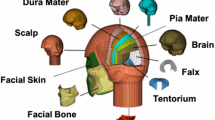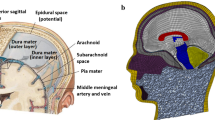Abstract
Injuries resulting from blast exposure have been increasingly prevalent in recent conflicts, with a particular focus on the risk of head injury. In the current study, a multibody model (GEBOD) was used to investigate the gross kinematics resulting from blast exposure, including longer duration events such as the fall and ground impact. Additionally, detailed planar head models, in the sagittal and transverse planes, were used to model the primary blast wave interaction with the head, and resulting tissue response. For severe blast load cases (scaled distance less than 2), the translational head accelerations during primary blast were found to increase as the height-of-burst (HOB) was lowered, while the HOB was found to have no effect for cases with scaled distance greater than 2. The HOB was found to affect both the magnitude and direction of rotational accelerations, with increasing magnitudes as the HOB deviated from the height of the head. The choice of ground contact stiffness was found to greatly affect the predicted head accelerations during ground impact. For a medium soil ground material, the kinematics during ground impact were greater for scaled distances exceeding 1.5, below which the primary blast produced greater kinematic head response.










Similar content being viewed by others
References
Ahlers, S. T., E. Vasserman-Stokes, et al. Assessment of the effects of acute and repeated exposure to blast overpressure in rodents: towards a greater understanding of blast and the potential ramifications for injury in humans exposed to blast. Front. Neurol. 3:1–12, 2012.
Bailey, A. M., Christopher, J. J., et al. Comparison of Hybrid-III and PMHS response to simulated underbody blast loading conditions. Proceedings of IRCOBI, IRC-13-25, Gothenburg, Sweden, 2013.
Bain, A. C., and D. F. Meaney. Tissue-level thresholds for axonal damage in an experimental model on central nervous system white matter injury. J. Biomech. Eng. 16:615–622, 2000.
Bass, C. D., M. Davis, et al. A methodology for assessing blast protection in explosive ordnance disposal bomb suits. Int J Occup. Saf. Ergon. 11(4):347–361, 2005.
Bouamoul, A. Numerical calculation of blast effect on human and on the mannequin for the assessment of blast incapacitation and lethality. DRDC Valcartier Technical Memorandum, TM 2008-285, 2008.
Bouamoul, A. Numerical study of primary blast injury to human and sheep lung induced by simple and complex blast loadings. DRDC Valcartier Technical Report, TR 2008-245, 2009.
Bustamante, M. C., and D. S. Cronin. Assessment of fluid cavitation threshold using a polymeric split Hopkinson bar confinement chamber apparatus. Greenville: Proc. SEM, 2018.
Chafi, M. S., G. Karami, et al. Biomechanical assessment of brain dynamic responses due to blast pressure waves. Ann. Biomed. Eng. 38(2):490–504, 2012.
Cheng, H., L. Obergefell, et al. Generator of Body (GEBOD) manual. Ohio: Wright-Patterson Air Force Base, Air Force Material Command, 1994.
Crocetta, G., S. Piantini, et al. The influence of vehicle front-end design on pedestrian ground impact. Accid. Anal. Prev. 79:56–69, 2015.
Cronin, D. S., Salisbury, C., et al. Numerical modeling of blast loading to the head. Proc. PASS, 84-93, Brussels, Belgium, 2008.
Deck, C., and R. Willinger. Improved head injury criteria based on head FE model. Int. J. Crashworth. 13(6):667–678, 2008.
DePalma, R. G., and S. W. Hoffman. Combat blast related traumatic brain injury (TBI): decade of recognition; promise of progress. Behav. Brain Res. 340:102–105, 2018.
Dionne, J. P., J. Nerenberg, et al. Reduction of blast-induced concussive injury potential and correlation with predicted blast impulse. Ottawa: Med-Eng Sys. Inc, 2002.
El Sayed, T., A. Mota, et al. Biomechanics of traumatic brain injury. Comput. Methods Appl. Mech. Eng. 197:4692–4701, 2008.
Elkin, B. S., Morrison, B. Region-specific tolerance criteria for the living brain. Stapp Car Crash J 51, 2007.
Flynn, M. State of the insurgency: trends, intentions, and objectives. Afghanistan: ISAF, 2009.
Fournier, E., Sullivan, D., et al. Blast Headform Development. DRDC Contract Report, CR 2007-234, 2007.
Franck, C. Microcavitation: the key to modeling blast traumatic brain injury? Concussion 2(3):CNC47, 2017.
Gayzik, F. S., Moreno, D. P., et al. Development of the Global Human Body Models Consortium mid-sized make full body model. Injury Biomechanics Research, Proc. 39th International Workshop, 2012.
Goeller, J., A. Wardlaw, et al. Investigation of cavitation as a possible damage mechanism in blast-induced traumatic brain injury. J. Neurotrauma 29(10):1970–1981, 2012.
Grujicic, M., G. Arakere, et al. Material-modeling and structural-mechanics aspects of the traumatic brain injury problem. Multidiscip. Model. Mater. Struct. 6(3):335–363, 2010.
Gupta, R. K., Przekwas, A. J. A framework for multiscale modeling of warfighter blast injury protection. Proceedings of ICCM, Auckland, New Zealand, July 2015.
Haladuick, T, N., Lockhart, P. A., et al. Head kinematics resulting from simulated blast loading scenarios. Proc. PASS, Nuremberg, Germany, 2012.
Helmick, K. M., C. A. Spells, et al. Traumatic brain injury in the US military: epidemiology and key clinical and research programs. Brain Imaging Behav. 9:358–366, 2015.
Ipek, H., Mayer, C., et al. Coupling of Strasbourg University head model to THUMS human body FE model, 21st Inter Tech Conf on the Enhanced Safety of Vehicles, Stuttgart, Germany, 2009.
Kabeyasawa, T., Hosokawa, Y., et al. Static and dynamic loading test on base foundation in a reinforced concrete school building. Proceedings of WCEE, Lisbon, Portugal, 2012.
Kleiven, S. Biomechanics and thresholds for mTBI in humans. MTBI Pre-Congress Symposium, IBIA Congress, Lisbon, Portugal, 2007.
Litt, O. P. Procedures for using the AMANDA model in acceleration response studies (tutorial by example). Army Research Laboratory Technical Report, ARL-TR-3333, 2004.
Lockhart, P., and D. S. Cronin. Helmet liner evaluation to mitigate head response from primary blast exposure. Comput. Methods Biomech. Biomed. Eng. 18(6):635–645, 2015.
Lockhart, P. A., D. S. Cronin, et al. Investigation of head response to blast loading. J. Trauma 70(2):E29–E36, 2011.
Ly, Q. H., A. Alaoui, et al. Towards a footwear design tool: Influence of shoe midsole properties and ground stiffness on the impact force during running. J. Biomech. 43:310–317, 2010.
Maach, S., von Rosen, B., et al. Comparison of Hybrid III head response to shock tube and explosive blast loading. Proceedings of IRCOBI, IRC-17-44, Antwerp, Belgium, 2017.
Magnus, D., Khan, M. A., Proud, W. G. Epidemiology of civilian blast injuries inflicted by terrorist bombings from 1970–2016. Defence Technology, In Press, 2018.
Makris, A., J. Nerenberg, et al. Reduction of blast induced head acceleration in the field of anti-personnel mine clearance. Ottawa: Med-Eng Sys. Inc, 2000.
Makwana, R., Zhang, L., et al. Comparison of the brain response to blast exposure between a human head model and a blast headform model using finite element methods. 13th Int LS-DYNA Users Conference, 2014.
Mao, H., F. Guan, et al. Strain based regional traumatic brain injury intensity in controlled cortical impact. J. Neurotrauma 28:2263–2276, 2011.
Moore, D. F., A. Jerusalem, et al. Computational biology: modeling of primary blast effects on the central nervous system. Neuroimage 47(2):T10–T20, 2009.
Panzer, M. B., B. S. Myers, and C. R. Bass. Mesh considerations for finite element blast modeling in biomechanics. Comput. Methods Biomech. Biomed. Eng. 16(6):612–621, 2011.
Panzer, M. B., B. S. Myers, et al. Development of a finite element model for blast brain injury and the effects of CSF cavitation. Ann. Biomed. Eng. 40(7):1530–1544, 2012.
Rueda, M. A. R., and M. D. Gilchrist. Comparative multibody dynamics analysis of falls from playground climbing frames. Forensic Sci. Int. 191:52–57, 2009.
Sarvghad-Moghaddam, H., A. Rezaei, et al. CFD modeling of the underwash effect of military helmets as a possible mechanism for blast-induced traumatic brain injury. Comput. Methods Biomech. Biomed. Eng. 20(1):16–26, 2017.
Schmitt, K., P. F. Niederer, D. S. Cronin, M. H. Muser, and F. Walz. Trauma Biomechanics: Introduction to Injury Biomechanics (4th ed.). Berlin: Springer, 2014.
Singh, D., and D. S. Cronin. Efficacy of visor and helmet for blast protection assessed using a computational head model. Shock Waves 27(6):905–918, 2017.
Singh, D., D. S. Cronin, et al. Head and brain response to blast using sagittal and transverse finite element models. Int. J. Numer. Methods Biomed. Eng. 30:470–489, 2014.
Skotak, M., E. Alay, et al. Effective testing of personal protective equipment in blast loading conditions in shock tube: comparison of three different testing locations. PLoS ONE 13(6):e0198968, 2018.
Smith, P. D., and J. G. Hetherington. Blast and Ballistic Loading of Structures. Oxford: Butterworth-Heineman, 1994.
Souli, M., K. Mahmadi, et al. ALE and fluid structure interaction. Mater. Sci. Forum 465:143–150, 2014.
Spitzer, V., M. J. Ackerman, et al. The visible human male: a technical report. J. Amer. Med. Inform. Ass 3(2):118–130, 1996.
Takhounts, E. G., S. A. Ridella, et al. Investigation of traumatic brain injuries using the next generation of simulated injury monitor (SIMon) finite element head model. Stapp Car Crash J. 52:1–31, 2008.
Tan, G., A. J. Przekwas, and R. K. Gupta. Computational modeling of blast induced human injury biomechanics and traumatic brain injury. J. Trauma Treat. 6(5):399, 2017.
Taylor, P. A., and C. C. Ford. Simulation of blast-induced early-time intracranial wave physics leading to traumatic brain injury. J. Biomech. Eng. 131(6):61007, 2009.
Taylor, P. A., J. S. Ludwigsen, and C. C. Ford. Investigation of blast-induced traumatic brain injury. Brain Inj. 28(7):879–895, 2014.
Ward, C., Chan, M., Nahum, A. Intracranial pressure: a brain injury criterion. SAE Technical Paper 801304, 1980.
Yin, S., J. Li, and J. Xu. Exploring the mechanisms of vehicle front-end shape on pedestrian head injuries caused by ground impact. Accid. Anal. Prev. 106:285–296, 2017.
Zhang, L., K. H. Yang, and A. I. King. A proposed injury threshold for mild traumatic brain injury. J. Biomech. Eng. 126(2):226, 2004.
Acknowledgments
The authors would like to thank the Natural Sciences and Engineering Research Council of Canada and the DND/NSERC supplement for financial support, and Compute Canada for providing the necessary computing resources.
Conflict of Interest
The authors declare no conflicts of interest.
Author information
Authors and Affiliations
Corresponding author
Additional information
Associate Editor Matthew B. Panzer oversaw the review of this article.
Publisher's Note
Springer Nature remains neutral with regard to jurisdictional claims in published maps and institutional affiliations.
Appendix: Exemplar Case of Linear and Rotational Acceleration Response
Appendix: Exemplar Case of Linear and Rotational Acceleration Response
The acceleration response curves for an exemplar case (10 kg of C4 at 4 m standoff and 0.2 m HOB) is shown in detail. The linear acceleration (Fig. 11) and rotational acceleration (Fig. 12) are presented, with the primary blast and first ground impact portions of the response shown in detail.
Rights and permissions
About this article
Cite this article
Singh, D., Cronin, D. Multi-Scale Modeling of Head Kinematics and Brain Tissue Response to Blast Exposure. Ann Biomed Eng 47, 1993–2004 (2019). https://doi.org/10.1007/s10439-018-02193-x
Received:
Accepted:
Published:
Issue Date:
DOI: https://doi.org/10.1007/s10439-018-02193-x






